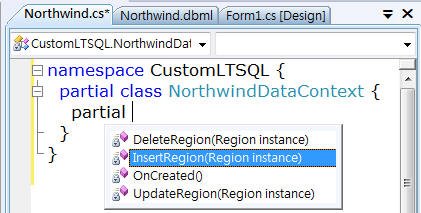摘要:Step-By-Step教學:改寫LINQ to SQL資料異動行為
原文:http://vmiv.blogspot.com/2008/03/linq-to-sql.html
LINQ to SQL提供一個簡單的資料存取模型,讓程式設計師能夠很容易地新增資料到資料庫,刪除資料庫資料,或對資料庫中既有的資料進行修改。預設LINQ to SQL會自動產生異動資料的T-SQL敘述來進行更新作業,但在預設行為不敷所需時,也可以很彈性地進行客製化動作。以下步驟說明客製化方式。
1. 建立一個Windows表單專案。
2. 加入LINQ to SQL類別,命為Northwind.dbml。
3. 開啟Server Explorer工具,連接到Northwind資料庫,然後將Region資料表拖曳到LINQ to SQL設計畫面左方的區塊之中。
4. 在伺服器總管,Northwind.dbml檔案方案滑鼠右鍵,選取「View Code」,Visual Studio 2008將會建立一個Northwind.cs檔案,其中包含一個NorthwindDataContext部分類別的定義。
5. 在NorthwindDataContext類別的大括號中,輸入partial一個字,Visual Studio會自動列出所有可以改寫的部分方法,包含InsertRegion、OnCreated、DeleteRegion與UpdateRegion方法,選取任一方法後,按Tab鍵,Visual Studio會自動產生方法的函式定義。
6. 修改Northwind.cs
 using System.Data;
using System.Data;02

03
 using System.Data.SqlClient;
using System.Data.SqlClient;04

05

 namespace CustomLTSQL {
namespace CustomLTSQL {06

07 partial class NorthwindDataContext
08
 {
{09

10 partial void InsertRegion(Region instance)
11
 {
{12

13 SqlConnection cn = new SqlConnection(this.Connection.ConnectionString);
14

15 SqlCommand cmd = new SqlCommand("Insert into Region values(@RegionID,@RegionDescription)", cn);
16

17 cmd.Parameters.AddWithValue("@RegionID", instance.RegionID);
18

19 cmd.Parameters.AddWithValue("@RegionDescription", instance.RegionDescription);
20

21 cn.Open();
22

23 cmd.ExecuteNonQuery();
24

25 cn.Close();
26

27
 }
}28

29 partial void DeleteRegion(Region instance)
30
 {
{31

32 SqlConnection cn = new SqlConnection(this.Connection.ConnectionString);
33

34 SqlCommand cmd = new SqlCommand("delete from Region where RegionID=@RegionID", cn);
35

36 cmd.Parameters.AddWithValue("@RegionID", instance.RegionID);
37

38 cn.Open();
39

40 cmd.ExecuteNonQuery();
41

42 cn.Close();
43

44
 }
}45

46 partial void UpdateRegion(Region instance)
47
 {
{48

49 SqlConnection cn = new SqlConnection(this.Connection.ConnectionString);
50

51 SqlCommand cmd = new SqlCommand("update Region set RegionDescription=@RegionDescription where RegionID=@RegionID", cn);
52

53 cmd.Parameters.AddWithValue("@RegionID", instance.RegionID);
54

55 cmd.Parameters.AddWithValue("@RegionDescription", instance.RegionDescription);
56

57 cn.Open();
58

59 cmd.ExecuteNonQuery();
60

61 cn.Close();
62

63
 }
}64

65
 }
}66

67
 }
}68

69
7. 在表單中加入三個Button,分別為Insert、Update、Delete,然後在其Click事件處理常式加入以下程式,分別進行新增、刪除、修改資料的動作:
 using System;
using System;02
 using System.Collections.Generic;
using System.Collections.Generic;03
 using System.ComponentModel;
using System.ComponentModel;04
 using System.Data;
using System.Data;05
 using System.Drawing;
using System.Drawing;06
 using System.Linq;
using System.Linq;07
 using System.Text;
using System.Text;08
 using System.Windows.Forms;
using System.Windows.Forms;09

10
 namespace CustomLTSQL
namespace CustomLTSQL11
 {
{12

13 public partial class Form1 : Form
14
 {
{15

16 public Form1()
17
 {
{18

19 InitializeComponent();
20

21
 }
}22

23 private void button1_Click(object sender, EventArgs e)
24
 {
{25

26 NorthwindDataContext db = new NorthwindDataContext();
27

28 Region r = new Region();
29

30 r.RegionID = 999;
31

32 r.RegionDescription = "new Region";
33

34 db.Regions.InsertOnSubmit(r);
35

36 db.SubmitChanges();
37

38
 }
}39

40 private void button2_Click(object sender, EventArgs e)
41
 {
{42

43 NorthwindDataContext db = new NorthwindDataContext();
44

45 Region reg = (from r in db.Regions
46

47 where r.RegionID == 999
48

49 select r).Single<Region>();
50

51 db.Regions.DeleteOnSubmit(reg);
52

53 db.SubmitChanges();
54

55
 }
}56

57 private void button3_Click(object sender, EventArgs e)
58
 {
{59

60 NorthwindDataContext db = new NorthwindDataContext();
61

62 Region reg = (from r in db.Regions
63

64 where r.RegionID == 999
65

66 select r).Single<Region>();
67

68 reg.RegionDescription = "Super new Region";
69

70 db.SubmitChanges();
71

72
 }
}73

74
 }
}75

76
 }
}77

78
79

80



 using
using 
